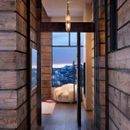Douglas Fir for Siding and Decking
Is Douglas fir an acceptable siding and decking option in northern utah?
This use of fir impresses me… I have stripped my exterior and applied prosoco WRB, and now have a year to complete the siding.
What are your thoughts on taking 2×6’s or possibly 2×8’s in fir, then
1. Table saw a 15 deg on both sides to shed water and provide the appearance of a ship lap gap.
2. Spray them with vinegar/steel wool to age the wood, and then spray them with a clear oil before installation over a rain screen.
What would you do differently? (use smartside is not an acceptable answer! 🙂 )
Thanks for the advice.
GBA Detail Library
A collection of one thousand construction details organized by climate and house part











Replies
At current lumber prices, siding with 2x6 or 2x8 seems somewhat impractical. My current project is sided with nominal 1X rough-sawn fir board-and-batten, locally milled. Coated with pigmented pine tar. The company that makes the pine tar (Auson) also makes a product they call Pine Tar Vitriol, which should be similar to the vinegar/steel wool + oil finish you propose.
For what it's worth, when testing finishes and siding types for this project, I found planed and sanded lumber (such as the dimensional framing lumber you propose) didn't absorb finishes very well or very evenly. Rough sawn material was far better. Rough sawn stock isn't available from any lumber yards near me, but I found a couple local small mills that would cut to order exactly what I wanted, at a fraction of the cost of materials from the lumberyard.
Referencing price, a 16 footer 2x6 is $20. I'm thinking that is pretty affordable at less than $3 a sq ft. Great point on sticking with rough sawn though and I had heard about tar, but need to dive into that. The way your's turned out is incredible and if that makes maintenance less of a hassle we'd probably go that direction.
Yeah, 'impractical' was maybe an overstatement.
Last summer, at the height of the market, I was paying about double that for a 16' 2x6, and the rough-sawn 1x I had custom milled was about $1.90/BF, or about $2/SF for the board-and-batten assembly. IIRC, the difference between $2 and $3/SF siding would more than pay for the cost of the pine tar finish.
Tar finish was pretty forgiving to apply, even with inexperienced labor. The smell is distinctive and pretty strong, but gone in a week or two. Manufacturer suggests 10 years or so between recoat. I left samples out all last winter, fully exposed and horizontal rather than vertical with no apparent ill effects. Have had minor issues with one particularly sappy batten strip that continued to weep after install. If I had it to do over, I'd probably cull the real sappy-looking pieces and use them for furring instead. Tar doesn't coat metal particularly well, so I used dark brown flashing, soffit vents, and electrical boxes, and hit any shiny fasteners with a little matte spray paint before tarring.
There's been others on GBA who've discussed using tar--that's where I first heard about it. Overall, very happy with it and would definitely use again.
Drake, How far away did you search for a mill? I talked to one yesterday that quoted $3 a lf for rough sawn 1x6's, which is more than Home Depot....
The guy I used is about 10 miles away, and the logs were harvested a little closer than that. Modest operation: bandsaw mill under an open shed, everything air-dried, also has a four-sided planer to run T&G flooring and siding. I paid $1.58/LF for rough sawn 1x10, $0.48/LF for 1x3 battens, and $3.25/SF for 4" T&G fir flooring. Also had him mill me some 4" beveled T&G cedar to line a small sauna. Don't have the cost of the cedar near at hand, but it was very reasonable and about 95% clear.
Earlier, I found a larger mill about 2.5 hr north that did kiln-dried pine for a little less than my local guy charged for fir. But getting it down to me would have more than eaten up the savings.
Mike ...Utah,
What you are suggesting is commonly called Open Cladding. The advantages are that it provides very good drying potential for the wall. The downsides are it moves most of the heavy lifting of keeping out bulk water and pests that's usually done by the siding back to the WRB. Most builders who use that approach specify a WRB specifically designed for that purpose.
Seconding what Malcolm said:
This is done a lot on higher-end homes in my area (Bozeman) - actually, the architecture firm whose photos you referenced is based here. It can look really badass - but you've really got to make sure your WRB is bomber.
Another thing to think about, depending on how large any gaps in the siding are & how much it moves, is that you will probably want to consider a blackout layer directly behind the siding - can be as simple as stapling up weed mat. That way if things move enough that you can see past the boards, you're not looking at furring strips or rigid insulation.
I also wonder if it wouldn't be easier to run a router down the edges of the boards to get whatever edge profile you want. Then you could work through the whole stack without lifting everything off the saw horses and plopping it on the table saw.
Deleted